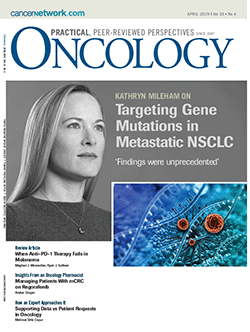Combining Chemotherapy and Immunotherapy for the Treatment of Triple-Negative Breast Cancer
Dr. McArthur discusses the latest results of immunotherapy trials in the treatment of triple-negative breast cancer.
Oncology (Williston Park). 33(4):137-40.

Heather McArthur, MD, MPH

Recently, various clinical trials have honed in on the use of immunotherapy to treat triple-negative breast cancer. The results of several such studies were presented at the European Society of Medical Oncology (ESMO) Annual Meeting and the San Antonio Breast Cancer Symposium (SABCS) in October and December of last year, respectively; results from several additional studies are anticipated in the next year. To identify key findings and their implications for clinical practice, ONCOLOGY spoke with Heather McArthur, MD, MPH, the Medical Director of Breast Oncology at the Samuel Oschin Comprehensive Cancer Institute at Cedars-Sinai Medical Center in Los Angeles.
Q:In December 2018, the results of the KEYNOTE-173 clinical trial-which tested pembrolizumab, an anti–programmed death 1 (PD-1) immune checkpoint antibody, as neoadjuvant treatment for triple-negative breast cancer-were presented at SABCS.[1] Could you tell us about the design of the study and the results?
DR. MCARTHUR: KEYNOTE-173 is a relatively small neoadjuvant study that explored various chemotherapy backbones in combination with the PD-1–directed antibody pembrolizumab. There were 10 patients enrolled in each of the trial’s 6 arms, so a total of 60 patients were evaluated. All patients received pembrolizumab with a taxane (paclitaxel or nab-paclitaxel) with or without a platinum followed by 4 cycles of doxorubicin plus cyclophosphamide before surgery. In cohort A, pembrolizumab was administered in combination with nab-paclitaxel. In the other arms, nab-paclitaxel or paclitaxel plus carboplatin were administered at various doses with pembrolizumab. The study investigators found that the pathologic complete response rate was much higher for two of the cohorts in which carboplatin was administered together with nab-paclitaxel; specifically, they observed a pathologic complete response rate of about 80% in these arms.[1] Again, although these data are from small numbers of patients, it is a notable finding when compared with chemotherapy-alone studies, wherein the pathologic complete response rate is usually 40% to 50%.
The study had a limited follow-up, so the investigators were not able to provide long-term, disease-specific, or overall survival results. However, they did demonstrate that for those patients who did achieve a complete response, their 12-month event-free survival was excellent.[1] Moreover, because patients with triple-negative breast cancer who achieve a pathologic complete response are more likely to be breast cancer–free for the rest of their lives, the long-term impact of such an improvement in pathological complete response rates is promising, potentially clinically significant, and warrants confirmation. Large randomized studies of neoadjuvant chemotherapy with or without checkpoint blockade have recently completed enrollment, and the results are anxiously awaited.
Q:There was also an accompanying presentation at SABCS about tumor-infiltrating lymphocytes (TILs) and their association with response to pembrolizumab.[2] Was there anything illuminating in this analysis that could inform future trials, and are there larger follow-up trials that are now testing pembrolizumab in the neoadjuvant setting?
DR. MCARTHUR: You’re absolutely correct that there was a companion poster presented in which the researchers investigated the role of stromal TILs and stromal programmed death ligand 1 (PD-L1) expression as predictors of response to therapy. Pembrolizumab targets PD-1, and PD-1 interacts with PD-L1, so the idea is that with higher stromal PD-L1, patients might potentially be more responsive to the immunotherapy treatment. The investigators reported that the ability to achieve a pathologic complete response was much higher in patients who had high levels of pretreatment stromal TILs and high levels of stromal PD-L1 expression. Again, the analysis was limited by the number of treatment samples and the number of patients treated on the study. But, this is an encouraging and consistent signal that shows that there is a potential role for prospective biomarkers that will enable us to ultimately enrich for patients who are more likely to receive benefit from these therapies.
Q: Are there additional neoadjuvant trials in triple-negative breast cancer with immunotherapy agents that have been read out or trials that you and your colleagues are looking forward to reading out?
DR. MCARTHUR: Absolutely. We do already have some additional data from the neoadjuvant setting. For example, the I-SPY2 neoadjuvant trial has an adaptive design that allows for efficient evaluation of specific combinations and predicts for the success of these combinations in the phase III setting.[3] This trial is not designed to look at various arms head-to-head, but rather to look for signals of promising combinations in individual arms. In one such arm, patients with triple-negative breast cancer treated with paclitaxel with or without pembrolizumab, followed by doxorubicin and cyclophosphamide, experienced a threefold improvement in the estimated pathologic complete response rate vs chemotherapy alone, from 20% to 60%, indicating a probability of success in a phase III trial of greater than 99%.[3] This was the first encouraging signal of immune therapy in the curative-intent setting.
At the American Society of Clinical Oncology Annual Meeting last year, we saw the results of the GeparNuevo trial, which was a randomized study of 174 patients who received chemotherapy with or without the PD-1–directed antibody durvalumab. We saw an almost 10% improvement in pathologic complete response with the addition of durvalumab to chemotherapy, although this was not statistically significant.[4] But what was interesting about this study is that there was a subset of patients treated with a durvalumab run-in before the chemotherapy was initiated, and these patients experienced an approximate 15% improvement in pathologic complete response rate, although an exploratory analysis later found the improvement to be not statistically significant.
Those are the some of the most recently reported data. The data we are anticipating, hopefully in 2019, are data from the IMpassion031 trial (ClinicalTrials.gov identifier: NCT03197935), a study of nab-paclitaxel followed by doxorubicin plus cyclophosphamide, with either placebo or the anti–PD-L1 immune checkpoint antibody atezolizumab, administered in the neoadjuvant setting. This study includes 204 patients, and the primary endpoint is pathologic complete response rate. The other large neoadjuvant study that has completed enrollment is the KEYNOTE-522 study. This is a study of neoadjuvant chemotherapy with or without pembrolizumab, followed by adjuvant pembrolizumab to complete 1 year of pembrolizumab treatment. The two co-primary endpoints of this study are pathologic complete response rate and event-free survival[5]; it is anticipated that the pathologic complete response rate data from KEYNOTE-522 will also be reported at an upcoming medical meeting.
There are also a number of ongoing large randomized phase III studies in the curative-intent setting. For example, the IMpassion030study will enroll 2,300 patients to receive adjuvant anthracycline- and taxane-based chemotherapy with or without atezolizumab (ClinicalTrials.gov identifier: NCT03498716). Another strategy is to enrich for patients who are at high risk of recurrence. The SWOG 1418 trial is doing that by enrolling patients with triple-negative breast cancer who have residual disease after standard chemotherapy and randomizing them to receive 1 year of pembrolizumab or no pembrolizumab (ClinicalTrials.gov identifier: NCT02954874). There are at least two studies that will be reported in the very near future, with highly anticipated results, and numerous global efforts in the curative-intent setting are currently underway. It’s a very exciting time.
Q: What is your perspective on immune checkpoint inhibitors in the neoadjuvant setting for patients with triple-negative disease? Are there already other neoadjuvant treatment options? How would these antibodies potentially fit into the treatment paradigm if larger studies show them to be efficacious?
DR. MCARTHUR: The standard curative-intent strategy for triple-negative breast cancer is chemotherapy. These newer strategies certainly build on that. The hope is that with more rational biologic combinations, we might be able to de-escalate the chemotherapy backbone. The whole idea of combining chemotherapy with immunotherapy is that if you can generate a robust tumor-specific immune response that is augmented by essentially killing tumor with chemotherapy, you can generate a long-term tumor-specific immune memory, so that if you are faced with that same information at a later date, in the form of a recurrence, ideally you wouldn’t even know it because your own immune system would recognize that tumor-specific information and go into attack mode to eliminate that recurrence.
The promise of immunotherapy is that it not only improves pathologic complete responses and early recurrences, but also translates into long-term meaningful improvements in cure rates. This is obviously so impactful for this disease specifically, because it affects so many young women and patients with BRCA deleterious mutations. The promise is incredible.
Q:Switching to immunotherapy agents in the metastatic triple-negative disease setting, the US Food and Drug Administration (FDA) just approved atezolizumab in combination with nab-paclitaxel for patients with PD-L1–positive tumors. The approval is based on the results of the phase III IMpassion130 trial that was published last October.[6] What are the key results from this trial?
DR. MCARTHUR: IMpassion130 focused on patients with newly diagnosed advanced triple-negative breast cancer who had not yet received chemotherapy in the palliative setting and who were at least 12 months from their adjuvant curative-intent chemotherapy. They were randomized to nab-paclitaxel with atezolizumab or placebo; the primary endpoint was progression-free survival, but the study was later expanded to allow for co-primary endpoints, including overall survival. In the intent-to-treat analysis, the 1-year progression-free survival rate was 24% for the atezolizumab arm vs 18% for the placebo arm, an almost 2-month improvement in progression-free survival for all patients.[6]
However, when you drill down into PD-L1–positive patients, the progression-free survival impact was much more pronounced, with an improvement from 5 months to 7.5 months. In the intent-to-treat population, there was an improvement in overall survival from 17.6 months to 21.3 months. However, this was not statistically significant because the investigators were unable to do an overall survival analysis in PD-L1–positive patients. In an informal analysis in the PD-L1–positive subset, the improvement in overall survival was almost 10 months (15.5 months vs 25 months with atezolizumab). It is worth noting that there has never been an improvement in overall survival with any prior strategies for the treatment of metastatic triple-negative breast cancer. To see this result, even in an informal analysis, is incredibly impactful.
Q: Lastly, what is the significance of the approval of atezolizumab? Could you place these trial results into context compared with currently used treatments?
DR. MCARTHUR: Given the results of IMpassion130,[6] and the recent FDA approval of atezolizumab with chemotherapy for the first-line treatment of PD-L1–positive metastatic triple-negative breast cancer based on the results of this study, this strategy will now be considered standard first-line therapy. It is exciting looking forward, since we are only starting to understand how to apply immunotherapy in the treatment of breast cancer.
Financial Disclosure:Dr. McArthur serves on advisory boards for AstraZeneca, Genentech, and Merck. She also receives research funding (provided to institution) from Merck.
PERSPECTIVE

Provocative Results Seen With Immune Checkpoint Blockade Generate Many Questions
Jennifer M. Specht, MD
The introduction and incorporation of immune checkpoint blockade into the treatment of many common cancers have revolutionized solid tumor oncology and solidified immunotherapy as the fourth pillar of oncology therapeutics. Breast cancer patients and advocates, as well as the breast oncology scientific community, celebrate the first US Food and Drug Administration–approved immune checkpoint inhibitor, atezolizumab, combined with nab-paclitaxel for the treatment of advanced triple-negative breast cancer-the most challenging breast cancer subtype.
In this interview, Dr. Heather McArthur articulately summarizes the current state and promise of immune checkpoint blockade in the neoadjuvant and advanced triple-negative breast cancer settings. The most immediate, practice-changing data come from the phase III IMpassion130 trial, presented in 2018 by Schmid et al, which shows prolonged progression-free survival with atezolizumab plus nab-paclitaxel vs placebo plus nab-paclitaxel (7.2 vs 5.5 months; hazard ratio, 0.80; 95% CI, 0.69–0.92; P = .002); further, it also demonstrated an impressive prolongation in overall survival, from 15.5 months to 25 months, with the addition of atezolizumab in patients with programmed death ligand 1 (PD-L1) expression in tumor immune cells.[1] As noted by Dr. McArthur, improvements in overall survival for patients with triple-negative breast cancer, even by an informal analysis, are noteworthy.
These provocative results generate many questions. Which biomarker is best to identify tumors most likely to respond to immune checkpoint blockade? PD-L1 expression on tumor and immune cell infiltration are among the most common; however, there remain important considerations with regard to heterogeneity of expression, reproducibility, and need for harmonization.[2] As discussed by Dr. McArthur, the presence of stromal tumor–infiltratinglymphocytes (sTILs) is a known prognostic biomarker in early breast cancers associated with improved response to chemotherapy alone and in combination with immune checkpoint blockade.[3] Tumor mutational burden and genomic profiles are also being evaluated as surrogates for breast cancer immunogenicity.
What about triple-negative breast cancers lacking PD-L1 immune cells, or sTILs, the “cold” or “immunologic desert” tumors? Leveraging our understanding of the many suppressive components of the breast tumor immune environment will be critical here. Combinations of checkpoint blockade agents, careful selection of chemotherapy, judicious use of radiation to modulate the microenvironment, intralesional therapies, and therapies targeting suppressive regulatory T cells and tumor-associated macrophages are all being evaluated as promising strategies to enhance endogenous cytotoxic T-cell response.
Beyond immune checkpoint blockade, a number of other exciting immuno-oncology modalities are under evaluation for triple-negative breast cancer that focus on enhancing immune response against tumor-associated antigens. These include vaccines, antibody-drug conjugates, oncolytic viruses, and, perhaps most directly, adoptive cellular immunotherapy using genetically modified T cells to directly interact with tumor antigens. T-cell receptors recognize tumor antigens in the context of major histocompatibility complex and chimeric antigen receptor (CAR) T cells, which combine the specificity of an antibody with the cytotoxic function of T cells. Our group is evaluating CAR T cells in ROR1-positive advanced triple-negative breast cancer (ClinicalTrials.gov identifier: NCT02706392).
It is a most exciting time in breast oncology, particularly for those impacted by triple-negative breast cancer. Continued advances for patients with triple-negative breast cancer will come with more sophisticated understanding of the breast tumor microenvironment and selection of rational and elegant immuno-oncology combinations.
Financial Disclosure:Dr. Specht has no significant financial interest in or relationship with the manufacturer of any product or provider of any service mentioned in this article.
Dr. Specht is an Associate Professor, Division of Medical Oncology, at the University of Washington, and an Associate Member, Clinical Research Division, at Fred Hutchinson Cancer Research Center, both in Seattle, Washington.
References:
1. Schmid P, Park YH, Muñoz-Couselo E, et al. KEYNOTE-173: Phase 1b multicohort study of pembrolizumab (Pembro) in combination with chemotherapy as neoadjuvant treatment for triple-negative breast cancer (TNBC). Presented at the 2018 San Antonio Breast Cancer Symposium; Dec 4-8, 2018; San Antonio, Texas. Poster PD5-01.
2. Loi S, Schmid P, Cortés J, et al. Relationship between tumor infiltrating lymphocytes (TILs) and response to pembrolizumab (Pembro)+chemotherapy (Chemo) as neoadjuvant treatment (NAT) for triple-negative breast cancer (TNBC): phase Ib KEYNOTE-173 trial. Presented at the 2018 San Antonio Breast Cancer Symposium; Dec 4-8, 2018; San Antonio, Texas. Poster P3-10-09.
3. Nanda R, Liu MC, Yau C, et al. Pembrolizumab plus standard neoadjuvant therapy for high-risk breast cancer (BC): Results from I-SPY 2. Presented at the 2017 American Society of Clinical Oncology Annual Meeting; June 2-6, 2017; Chicago, IL. Abstract 506.
4. Loibl S, Untch M, Burchardi N, et al. Randomized phase II neoadjuvant study (GeparNuevo) to investigate the addition of durvalumab to a taxane-anthracycline containing chemotherapy in triple negative breast cancer (TNBC). 2018;36(suppl):abstr 104.
5. Schmid P, Cortes J, Bergh JCS, et al. KEYNOTE-522: Phase III study of pembrolizumab (pembro) + chemotherapy (chemo) vs placebo + chemo as neoadjuvant therapy followed by pembro vs placebo as adjuvant therapy for triple-negative breast cancer (TNBC). 2018;36(suppl):abstr TPS602.
6. Schmid P, Adams S, Rugo HS, et al. Atezolizumab and Nab-Paclitaxel in Advanced Triple-Negative Breast Cancer. N Engl J Med. 2018;379:2108-21.
